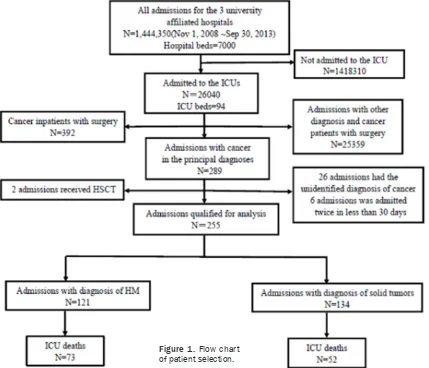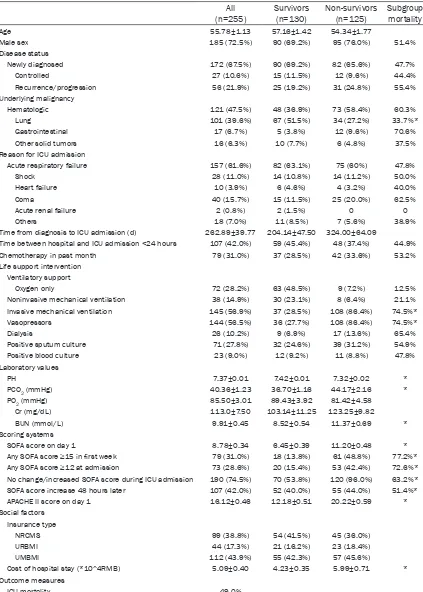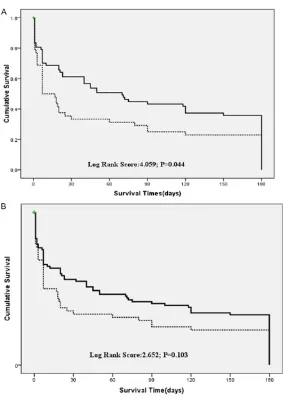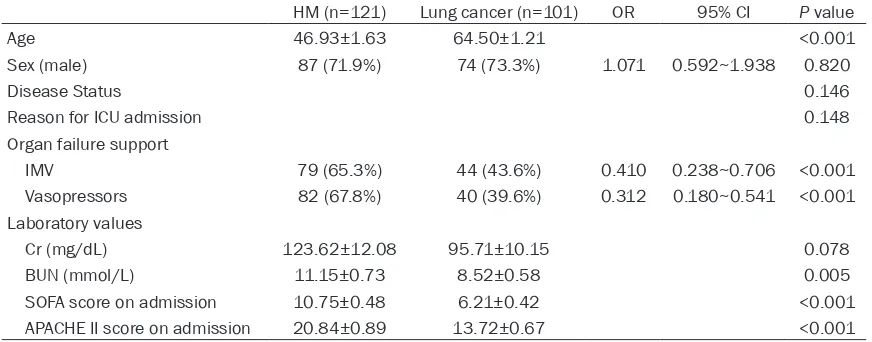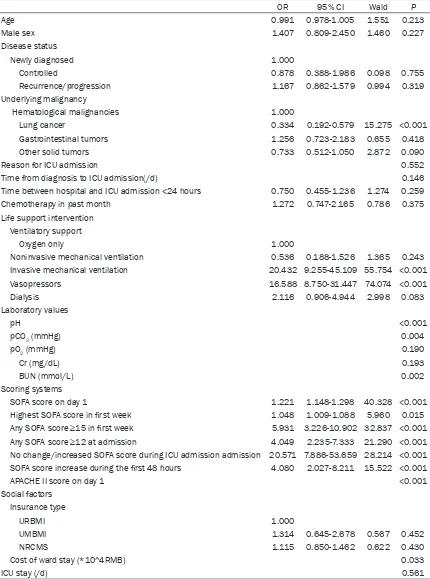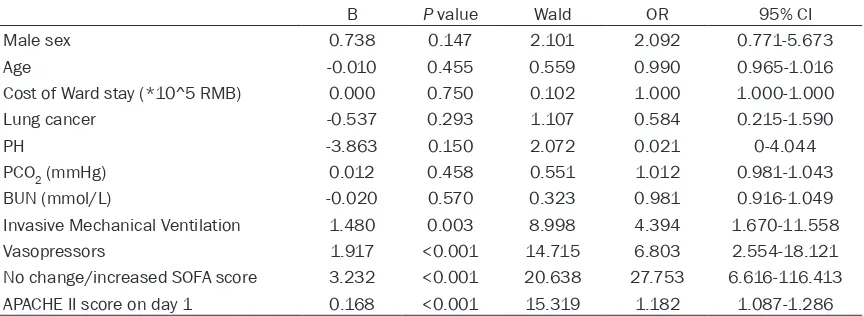Original Article
Factors affecting the prognosis of cancer patients in
general intensive care units in a Chinese population
Qian Cheng1*, Jing Liu1*, Qing Yang2, Erhua Wang1, Xiaohui Shen3, Kaveh Khoshnood2, Xin Li1
1Department of Hematology, Xiangya Third Hospital, Central South University, Changsha, Hunan, China; 2Department of Medicine, Yale New Haven Hospital, New Haven, Connecticut, USA; 3Department of Hematology,
Xiangya Second Hospital, Central South University, Changsha, Hunan, China. *Equal contributors.
Received March 2, 2016; Accepted June 5, 2016; Epub July 15, 2016; Published July 30, 2016
Abstract: Background: More and more cancer patients are admitted to intensive care units (ICUs) with acute life-threatening conditions. In West, the mortality of cancer patients admitted to ICUs has been substantially reduced thanks to advances in diagnosis and treatment. However, there is a paucity of data regarding the current situation of cancer patients admitted to ICUs in China. Methods: We performed a detailed retrospective review of 255 can-cer patients admitted to the ICUs of three university-affiliated hospitals in Hunan province over a five-year period. Outcome measure was ICU mortality rate, and was correlated with physiologic and therapeutic factors. We also evaluated the performance of two severity-of-illness scoring systems in this population. Results: During the studying period, the medical ICU plus Respiratory ICU (RICU) beds occupied 1.02% of all inpatients beds and received 1.8% of all inpatient admissions. The rates for ICU, one-month and six-month mortalities were 49.0%, 75.7% and 85.1%, respectively. Patients with lung cancer had better prognosis than other malignancies. No change or increased Sequential Organ Failure Assessment (SOFA) score, higher Acute Physiology and Chronic Health Evaluation (APACHE II) score at admission, and the need for invasive mechanical ventilation (IMV) and vasopressors were independently associated with ICU mortality. Conclusions: Cancer patients had less access to the intensive care resources in Hunan province of China than western countries. Both systemic illness and requirement for specific measures for organ failure predicted ICU mortality in this population. Based on our results, we proposed a set of clinical param-eters to guide patient management when considering ICU transfers.
Keywords: Intensive care, cancer, prognostic factors, mortality, access to care, China
Introduction
Worldwide each year, approximately 12.7 mil-lion people are diagnosed with cancer and 7.6 million die from it [1]. Cancer is also becoming the leading cause of death and disability among Chinese adults [1, 2]. Inadequate healthcare infrastructure and inequity in the distribution of medical resources further complicates the attempt to decrease the disease burden of can-cer in developing countries [3, 4].
Early diagnosis and effective treatment have substantially improved the average survival time for some cancer patients in the last two decades [3]. For instance, the survival for non-Hodgkin’s lymphoma and leukemia has signifi-cantly increased [5]. On the flip side, more and more cancer patients encounter
life-threaten-ing situations after aggressive treatment such as high-dose chemo-radiation and complica-tion rates are higher in patients with chronic comorbidities [6]. Cancer patients often require intensive care when admitted in the above settings.
Xing et al. had reviewed the data of 190 criti-cally ill cancer patients with postoperative respiratory insufficiency in China [11]. In addi-tion, results of a observational retrospective study analysed the score ability in predicting in-hospital mortality of critically ill cancer patients, but most of the patients were mainly underwent scheduled surgery (92.9%) [12]. However, the physiological and physical charac-teristics are totally different from cancer patients who can suffer from surgery or not. Moreover, little is known about the ICU course and prognosis of critically ill cancer patients who were not able to endure surgery in China. We had previously investigated the prognostic factors and mortality outcomes in patients with hematological malignancies (HM) in three uni-versity-affiliated hospitals in Hunan province of China [13]. The study revealed significant clinical outcome predictors and showed that patients in this region had relatively little
access to intensive care resources and high mortality compared to some results revealed by western researches [13]. However, the popu-lation of HM only accounts for less than 10% of all the cancer patients [14]. Therefore we want-ed to evaluate the access to intensive care and prognostic factors for critically ill patients with other malignancies in Hunan province
Methods
Patients and setting
[image:2.612.94.523.75.443.2]This study was deemed exempt from a formal review by the Ethics Committee of Central South University as no personally identifiable information would be collected. We conducted a detailed retrospective chart review of patients admitted from three university-affiliated hospi-tals in Hunan, China, from November 2008 to September 2013. The catchment area of these three hospitals spans Hunan province serving
amount of 60 million patients with diverse socioeconomic backgrounds. The three hospi-tals have about 25,000 cancer inpatient admis-sions each year. In addition to the general med-ical ICUs (MICU), all three hospitals have spe-cialized ICUs such as coronary care units, neu-roscience ICUs, pediatric ICUs, newborn ICUs, and respiratory ICUs (RICU) where lung cancer patients are admitted. As regional referral cen-ters, the MICUs (77 beds total) and RICUs (15 beds total) of these hospitals admit over 5,000 critically ill patients each year. The equipment of these units are in accordance with our previ-ously descriptions [13]. The same admission and transfer criteria were applied to cancer patients and other critically ill patients. ICU-level care was considered when a patient required frequent, close monitoring and the support of special equipment such as mechani-cal ventilation, continuous blood purification and intensive medication. The decision to admit or transfer to the ICU was made by the referring departments in collaboration with the intensive care specialists and required consent from the patient and/or family member. The same ICU admission protocol was used in all three hos- pitals and there was no substantial difference in the admission policy between MICUs and RICUs.
The flow chart in Figure 1 shows the process of case selection for the chart review. A total of 92 MICU and RICU beds (1.02% of all inpatient beds) received 26,040 inpatient admissions (1.8% of all inpatient admissions) in the study period. Among them, 289 admissions without surgical interventions listed cancer as the prin-cipal diagnosis; 392 additional cancer admis-sions involving surgery were excluded. Thirty-four admissions were excluded because the patients received hematopoietic stem cell transplant (HSCT, 2 admissions), had non-spe-cific diagnoses of cancer (26 admissions), or were readmissions within 30 days (6 admis-sions). Finally 255 admissions with cancer qualified for analysis.
For patients who had multiple readmissions to the same ICU, each admission was counted separately, unless it occurred within 30 days from the previous admission.
Data collection
The following background data were collected for each ICU admission: age, sex, principal
diag-noses, disease status, timing and reason for ICU admission, lengths of ICU and hospital stays, time-lapse between diagnosis and ad- mission, treatment regimen prior to ICU admis-sion, and the presence or absence of organ fail-ures. Disease status was coded into three cat-egories: controlled, defined as those who had undergone previous treatments (including che-motherapy, radiotherapy, etc) and had no sign of recurrence; newly diagnosed, defined as those who had been diagnosed with cancer in the last three months; recurrence/progression, defined as those with active disease status accessed by the hematology-oncology attend-ing physician or persistent disease insensitivity to standard chemotherapy. The definition of complete/partial remission of HM is the same as our previous study [13] and NCCN guidelines were also used to evaluate the disease status of each patient [15] (Supplement Table 1). In this study, we used two scoring systems to assess systemic illness-Acute Physiologic and Chronic Health E-valuation II (APACHE II) and Sequential Organ Failure Assessment (SOFA) [13]. The outcome measure was ICU mortality. The categorization of other clinical factors were described previously [13].
We also collected selected socioeconomic fac-tors, including the type of medical insurance, the place of residence (urban or rural), and the total cost of the hospital stay. Three main types of insurance were in wide use in Hunan prov-ince during the study-Urban Resident Basic Medical Insurance (URBMI), Urban Employee Basic Medical Insurance (UMBMI) and New Rural Cooperative Medical Insurance Scheme (NRCMS), each with different out-of-pocket ex- pense ratios [16].
Data analysis
Table 1. Characteristics of cancer admissions and variables associated with ICU mortality (N (%) or mean ± SEM)
All
(n=255) Survivors(n=130) Non-survivors(n=125) Subgroup mortality
Age 55.78±1.13 57.16±1.42 54.34±1.77
Male sex 185 (72.5%) 90 (69.2%) 95 (76.0%) 51.4%
Disease status
Newly diagnosed 172 (67.5%) 90 (69.2%) 82 (65.6%) 47.7%
Controlled 27 (10.6%) 15 (11.5%) 12 (9.6%) 44.4%
Recurrence/progression 56 (21.9%) 25 (19.2%) 31 (24.8%) 55.4% Underlying malignancy
Hematologic 121 (47.5%) 48 (36.9%) 73 (58.4%) 60.3%
Lung 101 (39.6%) 67 (51.5%) 34 (27.2%) 33.7%*
Gastrointestinal 17 (6.7%) 5 (3.8%) 12 (9.6%) 70.6%
Other solid tumors 16 (6.3%) 10 (7.7%) 6 (4.8%) 37.5%
Reason for ICU admission
Acute respiratory failure 157 (61.6%) 82 (63.1%) 75 (60%) 47.8%
Shock 28 (11.0%) 14 (10.8%) 14 (11.2%) 50.0%
Heart failure 10 (3.9%) 6 (4.6%) 4 (3.2%) 40.0%
Coma 40 (15.7%) 15 (11.5%) 25 (20.0%) 62.5%
Acute renal failure 2 (0.8%) 2 (1.5%) 0 0
Others 18 (7.0%) 11 (8.5%) 7 (5.6%) 38.9%
Time from diagnosis to ICU admission (d) 262.89±39.77 204.14±47.50 324.00±64.09
Time between hospital and ICU admission <24 hours 107 (42.0%) 59 (45.4%) 48 (37.4%) 44.9%
Chemotherapy in past month 79 (31.0%) 37 (28.5%) 42 (33.6%) 53.2%
Life support intervention Ventilatory support
Oxygen only 72 (28.2%) 63 (48.5%) 9 (7.2%) 12.5%
Noninvasive mechanical ventilation 38 (14.9%) 30 (23.1%) 8 (6.4%) 21.1% Invasive mechanical ventilation 145 (56.9%) 37 (28.5%) 108 (86.4%) 74.5%*
Vasopressors 144 (56.5%) 36 (27.7%) 108 (86.4%) 74.5%*
Dialysis 26 (10.2%) 9 (6.9%) 17 (13.6%) 65.4%
Positive sputum culture 71 (27.8%) 32 (24.6%) 39 (31.2%) 54.9%
Positive blood culture 23 (9.0%) 12 (9.2%) 11 (8.8%) 47.8%
Laboratory values
PH 7.37±0.01 7.42±0.01 7.32±0.02 *
PCO2 (mmHg) 40.36±1.23 36.70±1.16 44.17±2.16 *
PO2 (mmHg) 85.50±3.01 89.43±3.92 81.42±4.58
Cr (mg/dL) 113.0±7.50 103.14±11.25 123.25±9.82
BUN (mmol/L) 9.91±0.45 8.52±0.54 11.37±0.69 *
Scoring systems
SOFA score on day 1 8.78±0.34 6.45±0.39 11.20±0.48 *
Any SOFA score ≥15 in first week 79 (31.0%) 18 (13.8%) 61 (48.8%) 77.2%*
Any SOFA score ≥12 at admission 73 (28.6%) 20 (15.4%) 53 (42.4%) 72.6%*
No change/increased SOFA score during ICU admission 190 (74.5%) 70 (53.8%) 120 (96.0%) 63.2%* SOFA score increase 48 hours later 107 (42.0%) 52 (40.0%) 55 (44.0%) 51.4%*
APACHE II score on day 1 16.12±0.46 12.18±0.51 20.22±0.59 *
Social factors Insurance type
NRCMS 99 (38.8%) 54 (41.5%) 45 (36.0%)
URBMI 44 (17.3%) 21 (16.2%) 23 (18.4%)
UMBMI 112 (43.9%) 55 (42.3%) 57 (45.6%)
Cost of hospital stay (*10^4RMB) 5.09±0.40 4.23±0.35 5.99±0.71 * Outcome measures
ICU mortality 49.0%
Parameters that were statistically significant in the univariate analysis (P<0.05) were entered into the multivariate model in a stepwise man-ner and P<0.05 was required for the variable to retain itself within the model. A final boot-strap analysis was performed to confirm the conclusions.
Results
Patient characteristics and comparison be-tween ICU survivors and non-survivors
Table 1 shows the demographic and clinical data of the 255 ICU admissions involving can-cer patients. The majority of the patients (185, 72.5%) was male and the mean age was 55.78±1.13 years. HM accounted for 47.5% of
The rates for ICU mortalities was 49.0%. Compared to ICU survivors, patients who died in the ICU had significantly lower pH (7.32± 0.02 vs. 7.42±0.01, P<0.001), higher pCO2 (44.17±2.16 vs. 36.70±1.16, P=0.004), and higher BUN (11.37±0.69 vs. 8.52±0.54, P= 0.002). Non-survivors had significantly (P<0.05) higher APACHE-II and SOFA scores compared with the survivors. In addition, ICU non-survi-vors had a higher hospital cost (5.99±0.71*104 RMB vs 4.23±0.35*104 RMB, P<0.05).
Comparison between patients with HM and solid tumors
[image:5.612.91.376.66.463.2]In the initial analysis (Table 1), we noted that patients with lung cancer had better ICU sur-vival rates than patients with HM. The longer
Figure 2. A. Kaplan-Meier curves for survival. Haematological malignancy (Dotted line); lung cancer (Bolded line); B. Kaplan-Meier curves for survival. Haematological malignancy (Dotted line); solid tumour (Bolded line).
survival was also better in patients with lung cancer (P=0.044) and there was no significant-ly difference between patients with hematolo- gical malignancies or solid tumors (P=0.103) (Figure 2A, 2B). The better outcome prompts comparing between the two groups in detail (Table 2). The two groups did not differ signifi-cantly in gender, disease status, or the reason for ICU admission. Patients with lung cancer were significantly older than patients with HM. More HM patients suffered from renal failure and required IMV and vasopressors support. HM patients also had higher SOFA and APACHE II scores on ICU admission.
Factors affecting ICU mortality
Tables 3 and 4 show the results of the univari-ate and multivariunivari-ate logistic regression analy-sis of factors contributing to ICU mortality. Conditions shown to be significant (P<0.05) in the univariate analysis were incorporated into the multivariate model. Patient’s age, disease status, reason for ICU admissions, time-lapse between hospital and ICU admission and ICU length of stay did not significantly affect ICU mortality. In addition, some socioeconomic fac-tors such as gender and type of medical insur-ance were not associated with the outcome. Patients with the lung cancer had significantly lower ICU mortality than patients with other malignancies (OR 0.334, 95% CI 0.192-0.579, P<0.001). Patients receiving IMV (OR 20.432, 95% CI 9.255-45.109, P<0.001) and vaso- pressors (OR 16.588, 95% CI 8.750-31.447, P<0.001) had significantly higher ICU mortality
rates. Moreover, the cost of ward stay were associated with the ICU mortality (P=0.033). We assessed SOFA scores at several different time points and calculated the trend of change during the ICU stay. All of the SOFA measure-ments had significant correlation with ICU mor-tality, but the overall trend had the highest odds ratio and was incorporated into the multi-variate model. After correcting for age and sex, the model had excellent goodness-of-fit (Cox and Snell R2=0.549, Nagelkerke R2=0.732, Chi-square=4.885, P=0.770). In our model, no change or increased in SOFA score, APACHE II score at admission, the need for invasive mechanical ventilation, and the need for vaso-pressors were independent prognostic factors associated with ICU mortality.
Discussion
This study aimed to evaluate the access to intensive care and prognostic factors affecting cancer patients admitted to the ICU in a Chinese population. Our previous work had shown that compared to some results of Western studies, patients with hematologic malignancies had poor access to intensive care resources and experienced relatively high mor-tality rates during and after ICU admission in Hunan province of China [13]. In the current study, we wanted to see if what we observed with HM patients was representative of other cancer patients.
We found that cancer patients in general had poor access to the medical ICUs in the three Table 2. The comparison between patients with HM and lung cancer patients (n% or ± SEM)
HM (n=121) Lung cancer (n=101) OR 95% CI P value
Age 46.93±1.63 64.50±1.21 <0.001
Sex (male) 87 (71.9%) 74 (73.3%) 1.071 0.592~1.938 0.820
Disease Status 0.146
Reason for ICU admission 0.148
Organ failure support
IMV 79 (65.3%) 44 (43.6%) 0.410 0.238~0.706 <0.001
Vasopressors 82 (67.8%) 40 (39.6%) 0.312 0.180~0.541 <0.001
Laboratory values
Cr (mg/dL) 123.62±12.08 95.71±10.15 0.078
BUN (mmol/L) 11.15±0.73 8.52±0.58 0.005
SOFA score on admission 10.75±0.48 6.21±0.42 <0.001
APACHE II score on admission 20.84±0.89 13.72±0.67 <0.001
Table 3. Univariate analysis of factors associated with ICU mortality
OR 95% CI Wald P
Age 0.991 0.978-1.005 1.551 0.213
Male sex 1.407 0.809-2.450 1.460 0.227
Disease status
Newly diagnosed 1.000
Controlled 0.878 0.388-1.986 0.098 0.755
Recurrence/progression 1.167 0.862-1.579 0.994 0.319
Underlying malignancy
Hematological malignancies 1.000
Lung cancer 0.334 0.192-0.579 15.275 <0.001
Gastrointestinal tumors 1.256 0.723-2.183 0.655 0.418
Other solid tumors 0.733 0.512-1.050 2.872 0.090
Reason for ICU admission 0.552
Time from diagnosis to ICU admission(/d) 0.146
Time between hospital and ICU admission <24 hours 0.750 0.455-1.236 1.274 0.259
Chemotherapy in past month 1.272 0.747-2.165 0.786 0.375
Life support intervention Ventilatory support
Oxygen only 1.000
Noninvasive mechanical ventilation 0.536 0.188-1.526 1.365 0.243
Invasive mechanical ventilation 20.432 9.255-45.109 55.754 <0.001
Vasopressors 16.588 8.750-31.447 74.074 <0.001
Dialysis 2.116 0.906-4.944 2.998 0.083
Laboratory values
pH <0.001
pCO2 (mmHg) 0.004
pO2 (mmHg) 0.190
Cr (mg/dL) 0.193
BUN (mmol/L) 0.002
Scoring systems
SOFA score on day 1 1.221 1.148-1.298 40.328 <0.001
Highest SOFA score in first week 1.048 1.009-1.088 5.960 0.015
Any SOFA score ≥15 in first week 5.931 3.226-10.902 32.837 <0.001 Any SOFA score ≥12 at admission 4.049 2.235-7.333 21.290 <0.001 No change/increased SOFA score during ICU admission admission 20.571 7.886-53.659 28.214 <0.001 SOFA score increase during the first 48 hours 4.080 2.027-8.211 15.522 <0.001
APACHE II score on day 1 <0.001
Social factors Insurance type
URBMI 1.000
UMBMI 1.314 0.645-2.678 0.567 0.452
NRCMS 1.115 0.850-1.462 0.622 0.430
Cost of ward stay (*10^4RMB) 0.033
ICU stay (/d) 0.561
Abbreviations: Intensive Care Unit (ICU); Odds Ratio (OR); Confidential Interval (CI); Creatinine (Cr); Blood Urea Nitrogen (BUN);
university-affiliated hospitals in Hunan prov-ince. During our study period, 26,040 patients (1.8% of all admissions) stayed in the 92 MICU and RICU beds (1.02% of all inpatient beds). Our data were similar to another multicenter study in China, in which medical ICU beds accounted for 1.26% of all inpatient beds [17]. Compared to Western countries, where medi-cal ICU beds occupy 1.8%-5% of all inpatient beds and received 1.99%-4.1% of inpatient admissions [18, 19], the availability of Hunan’s medical intensive care resources is limited. In our study, only 681 (Figure 1) ICU admissions, including those for post-operative care, involved patients with cancer. Cancer was the primary diagnosis in less than 3% of all ICU admissions, much lower than what was observed previously [7, 20]. This points to the fact that patients with cancer have reduced access to intensive care in Hunan province. In addition to the scarcity of intensive care resources, we speculate that presumed poor prognosis for cancer patients, coupled with the high cost of care and associ-ated out-of-pocket expenses, may be prevent-ing medical providers and families from trans-ferring patients to the ICU [21]. These results suggested that it would be necessary to im- prove ICU admission by carrying better insur-ance, by increasing the availability of hospital ICU beds, or by stretching the criteria of admis-sion to ICU.
We observed that patients with solid tumors, particularly lung cancer, had considerably bet-ter prognosis than patients with HM, consistent with previous studies [10, 22]. Comparing the
two groups revealed that more patients with HM experienced renal failure, need IMV and vasopressors, and had higher SOFA and APACHE II scores on ICU admission. Patients with HM also more frequently suffered severe sepsis and required rigorous treatments [13], which may be associated with complications and organ failures [7]. Furthermore, solid tumors were often regarded as chronic diseas-es and the health profildiseas-es of thdiseas-ese patients were similar to the non-cancer populations [10], associated with better outcomes. In con-trast, HM admissions to the ICU often resulted from acute deteriorations such as blast crisis, aplastic crisis, and neutropenia [13]. Lastly, the three academic hospitals in our study had spe-cialized respiratory ICUs that enabled prompt admission and treatment of lung cancer patients. To some extent, RICUs are an exam-ple of broadened ICU access for cancer pa- tients. Optimizing ICU admission policies for HM patients may be needed to improve their survival.
[image:8.612.91.523.85.243.2]In our sample, trends of SOFA scores, APACHE II scores at admission, the need for invasive mechanical ventilation, and vasopressor use were independently associated with increased ICU mortality of cancer patients. Other clinical parameters, such as disease status, reason for ICU admission, and time-lapse between hospi-tal and ICU admission, did not have significant correlation with outcomes. These results are consistent with some early studies from our and other groups [7-9, 13, 23]. The predictive effect of vasopressor use was not observed in Table 4. Multivariate analysis of factors affecting ICU mortality
B P value Wald OR 95% CI
Male sex 0.738 0.147 2.101 2.092 0.771-5.673
Age -0.010 0.455 0.559 0.990 0.965-1.016
Cost of Ward stay (*10^5 RMB) 0.000 0.750 0.102 1.000 1.000-1.000
Lung cancer -0.537 0.293 1.107 0.584 0.215-1.590
PH -3.863 0.150 2.072 0.021 0-4.044
PCO2 (mmHg) 0.012 0.458 0.551 1.012 0.981-1.043
BUN (mmol/L) -0.020 0.570 0.323 0.981 0.916-1.049
Invasive Mechanical Ventilation 1.480 0.003 8.998 4.394 1.670-11.558
Vasopressors 1.917 <0.001 14.715 6.803 2.554-18.121
No change/increased SOFA score 3.232 <0.001 20.638 27.753 6.616-116.413
APACHE II score on day 1 0.168 <0.001 15.319 1.182 1.087-1.286
Abbreviations: Intensive Care Unit (ICU); Odds Ratio (OR); Confidential Interval (CI); Blood Urea Nitrogen (BUN); Sequential
our previous study of HM patients, even though the ICU mortality was non-significantly elevated in patients on vasopressors [13]. The larger sample size in the current study may have helped reveal vasopressor use as an indepen-dent predictor. Since vasopressor use is a sur-rogate for the hemodynamic changes caused by heart failure or septic shock [24, 25], moni-toring and assessment of the hemodynamic state of cancer patients would be crucial for management decisions in the ICU.
In addition to clinical parameters, we also eval-uated the contribution of socioeconomic fac-tors to patient outcome. Gender, type of medi-cal insurance, and cost of hospitalization did not have significant effect on the ICU mortality of the cancer patients. Even though non-survi-vors incurred higher cost during the ICU stay (5.99±0.71*10^4 RMB VS 4.23±0.35*10^4 RMB, P=0.033), cost lost significance when entered into the model with clinical factors. However we noted that our study sample was predominantly male carrying urban insurance policies, suggesting that socioeconomic fac-tors may play into the decision of ICU admission and patients’ access to intensive care reso- urces.
Our study had several limitations. The retro-spective study design prevented more detailed data collection to include other physiologic and social characteristics which may be pertinent to the outcomes. And also the data is limited (only 255 cases) for more detailed group analy-sis. But to our knowledge, this is the first study to investigate the prognostic factors for Chinese cancer patients without surgery admitted to the ICU. We believe it at least represents part of the current situation in Chinese cancer patients’ intensive care. We hope the series of clinical determinants reported here could offer guid-ance help for Chinese physicians to make clini-cally appropriate and cost effective decisions about ICU admissions.
Acknowledgements
This study was supported by the Fundamental Research Funds for the Central Universities of Central South University, N0. 2016zzts151 and NIH program, NO. #1 R25 TW007700-01A1 and the National Natural Science Foundation of China (General Program), N0. 81470361.
Disclosure of conflict of interest
None.
Address correspondence to: Dr. Xin Li, Department of Hematology, The Third Xiangya Hospital, Central South University, Changsha 410013, Hunan, China. Tel: +86-731-88618814 (88618214); Fax: 0731-88618014; E-mail: lixiner1975@163.com
References
[1] Jemal A, Bray F, Center MM, Ferlay J, Ward E, Forman D. Global cancer statistics. CA Cancer J Clin 2011; 61: 69-90.
[2] He J, Gu D, Wu X, Reynolds K, Duan X, Yao C, Wang J, Chen CS, Chen J, Wildman RP, Klag MJ, Whelton PK. Major causes of death among men and women in China. N Engl J Med 2005; 353: 1124-1134.
[3] Hvistendahl M. China. World’s biggest health care system goes under the knife. Science 2013; 339: 505-507.
[4] Brenner H. Long-term survival rates of cancer patients achieved by the end of the 20th cen-tury: a period analysis. Lancet 2002; 360: 1131-1135.
[5] Brenner H, Gondos A and Arndt V. Recent ma-jor progress in long-term cancer patient sur-vival disclosed by modeled period analysis. J Clin Oncol 2007; 25: 3274-3280.
[6] Torheim H and Kvangarsnes M. How do pa-tients with exacerbated chronic obstructive pulmonary disease experience care in the in-tensive care unit? Scand J Caring Sci 2014; 28: 741-748.
[7] Merz TM, Schar P, Buhlmann M, Takala J, Rothen HU. Resource use and outcome in criti-cally ill patients with hematological malignan-cy: a retrospective cohort study. Crit Care 2008; 12: R75.
[8] Azoulay E, Moreau D, Alberti C, Leleu G, Adrie C, Barboteu M, Cottu P, Levy V, Le Gall JR, Schlemmer B. Predictors of short-term mortal-ity in critically ill patients with solid malignan-cies. Intensive Care Med 2000; 26: 1817-1823.
[9] Maschmeyer G, Bertschat FL, Moesta KT, Häusler E, Held TK, Nolte M, Osterziel KJ, Papstein V, Peters M, Reich G, Schmutzler M, Sezer O, Stula M, Wauer H, Wörtz T, Wischnewsky M, Hohenberger P. Outcome analysis of 189 consecutive cancer patients referred to the intensive care unit as emergen-cies during a 2-year period. Eur J Cancer 2003; 39: 783-792.
out-comes of cancer patients in European ICUs. Crit Care 2009; 13: R15.
[11] Xing XZ, Gao Y, Wang HJ, Yang QH, Huang CL, Qu SN, Zhang H, Wang H, Xiao QL, Sun KL. Risk factors and prognosis of critically ill cancer pa-tients with postoperative acute respiratory in-sufficiency. World J Emerg Med 2013; 4: 43-47.
[12] Xing X, Gao Y, Wang H, Huang C, Qu S, Zhang H, Wang H, Sun K. Performance of three prog-nostic models in patients with cancer in need of intensive care in a medical center in China. PLoS One 2015; 10: e131329.
[13] Liu J, Cheng Q, Yang Q, Li X, Shen X, Zhang L, Liu Z, Khoshnood K. Prognosis-related factors in intensive care unit (ICU) patients with hema-tological malignancies: A retrospective cohort analysis in a Chinese population. Hematology 2015; 20: 494-503.
[14] Ferlay J, Autier P, Boniol M, Heanue M, Colombet M, Boyle P. Estimates of the cancer incidence and mortality in Europe in 2006. Ann Oncol 2007; 18: 581-592.
[15] NCCN. The NCCN clinical practice guidelines in oncology (version 1.2014). http://www.nccn. org/professionals/physician_gls/f_guidelines. asp.
[16] Tang S, Tao J and Bekedam H. Controlling cost escalation of healthcare: making universal health coverage sustainable in China. BMC Public Health 2012; 12 Suppl 1: S8.
[17] Du B, An Y, Kang Y, Yu X, Zhao M, Ma X, Ai Y, Xu Y, Wang Y, Qian C, Wu D, Sun R, Li S, Hu Z, Cao X, Zhou F, Jiang L, Lin J, Chen E, Qin T, He Z, Zhou L. Characteristics of critically ill patients in ICUs in mainland China. Crit Care Med 2013; 41: 84-92.
[18] Bird GT, Farquhar-Smith P, Wigmore T, Potter M and Gruber PC. Outcomes and prognostic fac-tors in patients with haematological malignan-cy admitted to a specialist cancer intensive care unit: a 5 yr study. Br J Anaesth 2012; 108: 452-459.
[19] Capelastegui A, Espana PP, Quintana JM, Areitio I, Gorordo I, Egurrola M, Bilbao A. Validation of a predictive rule for the manage-ment of community-acquired pneumonia. Eur Respir J 2006; 27: 151-157.
[20] Soares M, Salluh JI, Torres VB, Leal JV and Spector N. Short- and long-term outcomes of critically ill patients with cancer and prolonged ICU length of stay. Chest 2008; 134: 520-526. [21] Varghese C, Carlos MC and Shin HR. Cancer
burden and control in the Western pacific re-gion: challenges and opportunities. Ann Glob Health 2014; 80: 358-369.
[22] Thiery G, Azoulay E, Darmon M, Mikane T, Oku S, Iwasaki E, Ishii M, Mieda H, Ishikawa T, Minami E, Schlemmer B. Outcome of cancer patients considered for intensive care unit ad-missin: a hospital-wide prospective study. J Clin Oncol 2005; 23: 4406-4413.
[23] Kress JP, Christenson J, Pohlman AS, Linkin DR and Hall JB. Outcomes of critically ill cancer patients in a university hospital setting. Am J Respir Crit Care Med 1999; 160: 1957-1961. [24] Zechmeister C, Hurren J and McNorton K.
Continuation of Statin Therapy and Vasopre- ssor Use in Septic Shock. Ann Pharmacother 2015; 49: 790-5.
Supplement Table 1. The definition of disease status in NCCN guidelines (Version 2014) [1, 2] Solid tumors Definition
Lung cancer The NCCN guidelines use the AJCC (7th edition) staging system for lung cancer. With the new staging, locally
advanced disease is now stage III, advanced disease is now stage IV. Pathologic staging uses both clinical staging information and other invasive staging procedures.
Colon cancer The 7th edition of the American Jonit Committee on Cancer’s (AJCC) includes the suggestion that patients with
potentially convertable metastatic disease that is not responding to therapy. Poor prognostic features are poorly differentiated histology; lymphatic/vascular invasion; bowel obstruction; perineural invasion; localized perfora-tion; close, indeterminate or positive margins.
Rectal cancer Some of the information are detailed in: grade of cancer; depth of penetration and extension to adjacent struc-tures; number of regional lymph nodes evaluated; the presence of distant metastases to other organs or sites including non-regional lymph nodes and the response to treatment.
Hematological malignancies Acute myeloid leukemia
Complete remission Morphologic CR (patient independent of transfusions): Absolute neutrophil count >1000/
mcL; Platelets ≥100,000/mcL; No residual evidence of extralmedullary disease. Cytogenet -ic complete response-ics normal ( in those with previously abnormal cytogenet-ics). Molecular complete response- molecular studies negative.
Partial remission Decrease of at least 50% in the percentage of blasts to 5% to 25% in the bone marrow aspirate and the normalization of blood counts, as noted above. Patients failing to achieve a complete response are considered treatment failures. Relapse following complete
response is defined as reappearance of leukemic blasts in the peripheral blood or the finding of more than 5% blasts in the bone marrow, not attributable to another cause or
extramedullary relapse.
Acute lymphoblatic leukemia Complete remission No circulating blasts or extramedullary disease; trilineage hematopoiesis and <5% blasts; absolute neutrophil count >1000/microL; platelets >100,000/microL; no recurrence for 4 weeks.
Refractory disease Failure to achieve CR at the end of induction.
Progressive disease Increase of at least 25% in the absolute number of circulating or bone marrow blasts or development of extralmedullary disease.
Relapsed disease Reappearance of blasts in the blood or bone marrow (>5%) or in any extramedullary site after a CR.
Multiple Myeloma Complete response Negative immunofixation on the serum and urine and disappearance of any soft tissue plasmacytomas and ≤5% plasma cells in bone marrow.
Progressive disease Requires any one or more of the following: increase of ≥25% from baseline in: serum M-component and/or (the absolute increase must be ≥0.5 g/dL); Urine M-M-component and/or (the absolute increase must be ≥200 mg/24 h); only in patients without measurable serum
and urine M-protein levels: the difference between involved and uninvolved FLC levels. The absolute increase must be >10 mg/dl. Bone marrow plasma cell percentage: the absolute
% must be >10%. Definite development of new bone lesions or soft tissue plasmacytomas or definite increase in the size of existing bone lesions or soft tissue plasmacytomas or definite increase in the size of ex siting bone lesions or soft tissue plamacytomas; develop -ment of hypercalsemia (corrected serum calcium >11.5 mg/dL or 2.65 mmol/L) that can be attributed solely to the plasma cell proliferative disorder.
Non-Hodgkin’s Lymphomas Complete remission Disappearance of all evidence of disease.
Relapsed disease Any new lesion or increase by ≥50% of previously involved sites from dadir.
[1] NCCN. The NCCN clinical practice guidelines in oncology (version 1.2014). http://www.nccn.org/profession-als/physician_gls/f_guidelines.asp.
Supplement Table 2. Covariance between parameters in univariate analysis (P<0.05), checked with Pearson’s correlation test
Cost Age Sex cancer pCOLung 2 Cr BUN IMV
Vaso-pressors
APACHE II on ad-mission
No change/ increased SOFA score
Cost Pearson correlation 1 .036 .033 -.217** .020 -.008 -.052 .198** .233** .097 .085 sig.(2-tailed) .578 .612 .001 .761 .898 .424 .002 .001 .131 .190
Age Pearson correlation .036 1 .176** .392** .142* .005 -.020 -.039 -.110 -.009 -.064 sig.(2-tailed) .578 .005 .001 .023 .933 .746 .538 .080 .889 .308
Sex Pearson correlation .033 .176** 1 .013 .033 .154* .171** .103 .045 .063 -.077 sig.(2-tailed) .612 .005 .836 .603 .014 .006 .101 .476 .319 .217
Lung cancer Pearson correlation -.217** .392** .013 1 .079 -.117 -.159* -.217** -.276** -.264** -.152* sig.(2-tailed) .001 .001 .836 .208 .062 .011 .001 .001 .001 .015
PCO2 Pearson correlation .020 .142* .033 .079 1 -.079 -.132* .118 .092 .175** .075 sig.(2-tailed) .761 .023 .603 .208 .209 .035 .059 .141 .005 .231
Cr Pearson correlation -.008 .005 .154* -.117 -.079 1 .570** .094 .188** .231** .088 sig.(2-tailed) .898 .933 .014 .062 .209 .001 .135 .003 .001 .160
BUN Pearson correlation -.052 -.020 .171** -.159* -.132* .570** 1 .099 .263** .291** .125* sig.(2-tailed) .424 .746 .006 .011 .035 .001 .113 .001 .001 .047
IMV Pearson correlation .198** -.039 .103 -.217** .118 .094 .099 1 .577** .425** .326** sig.(2-tailed) .002 .538 .101 .001 .059 .135 .113 .001 .001 .001
Vasopressors Pearson correlation .233** -.110 .045 -.276** .092 .188** .263** .577** 1 .408** .303** sig.(2-tailed) .001 .080 .476 .000 .141 .003 .001 .001 .001 .001 APACHE II on
admission
Pearson correlation .097 -.009 .063 -.264** .175** .231** .291** .425** .408** 1 .275**
sig.(2-tailed) .131 .889 .319 .001 .005 .001 .001 .001 .001 .001 No
change/in-creased SOFA score
Pearson correlation .085 -.064 -.077 -.152* .075 .088 .125* .326** .303** .275** 1
